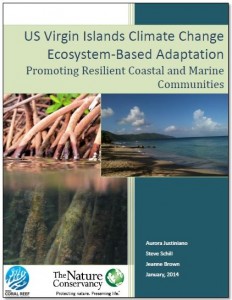U.S. Virgin Islands Climate Change Ecosystem-Based Adaptation Guidance: Promoting Resilient Coastal and Marine Communities
Location
U.S. Virgin Islands
The challenge
Coastal and marine communities of the U.S. Virgin Islands (USVI), similar to other locations worldwide, are susceptible to the effects of climate change including increasing hazardous coastal conditions and loss of life-sustaining marine, coastal, and island resources. Climate change is anticipated to add to the stresses of our coastal environment by altering temperature patterns, increasing the likelihood of extreme precipitation events, and accelerating rates of sea-level rise. Responding and adapting to such changes requires an understanding of the risks; weighing options for adapting to changing conditions; and instituting a suite of strategies to fund, implement, and measure response actions that have the most benefits to the ecosystems and communities that depend on them.
There is a growing volume of evidence that suggests in some situations, the most successful and cost-effective actions to protect people from the impacts of climate change are to preserve, enhance, and restore natural systems that provide critical protection, or that provide food, water, or work opportunities to local communities. Ecosystem-based adaptation (EBA), or nature-based adaptation to climate change, is a holistic response based on the premise and experience that by protecting, maintaining, and restoring natural ecosystems, we can reduce the scale and scope of impacts to human communities and to the natural systems upon which they depend. Ecosystems are the first line of defense against impacts of climate change and a key aspect of EBA is to design and implement solutions that integrate nature’s infrastructure – mangrove forests, wetlands, coral reefs, and beaches – with human infrastructure and socioeconomic needs.
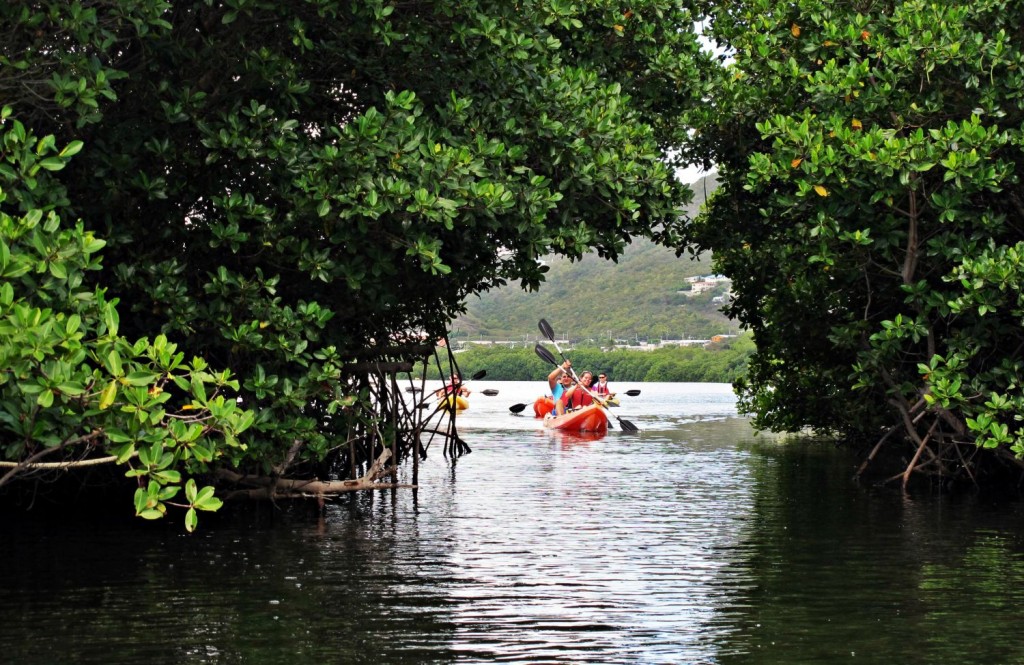
Sea level rise will impact mangrove forests and critical functions that they serve, such as storm surge mitigation. Photo © Brenda Sylvia
Actions taken
With support from National Oceanic and Atmospheric Administration’s (NOAA) Coral Reef Conservation Program, The Nature Conservancy’s (TNC) Caribbean Program led a project with the objective of developing decision-support tools and conservation strategies that will advance the implementation of ecosystem-based adaptation to climate change within the USVI. This initiative draws on stakeholder and expert knowledge of the territory, including understanding of existing development stresses, in order to identify critical socioeconomic and ecosystem vulnerabilities to climate change and to identify feasible options for adaptation.
To support implementation of EBA in the USVI, TNC conducted the following: (a) socioeconomic vulnerability analysis, (b) mangrove migration analysis, and (c) identification of EBA sites. Results from these analyses were presented and discussed with local stakeholders and experts during the USVI Climate Change Ecosystem-based Adaptation Workshop held in June 2013.
Socioeconomic Vulnerability Analysis
A spatial analysis was conducted to examine the socioeconomic vulnerability to climate change for the 336 estates (neighborhoods) within the U.S. Virgin Islands. To assess the socioeconomic vulnerability of communities, TNC used 2010 census information to construct indices for the following variables:
- Social Sensitivity – suite of variables and aggregate view that provide a sense of a communities’ overall sensitivity to storm surge and climate change;
- Adaptive Capacity – represents human and civic resources that are critical components for coping with disasters including literacy, level of education, access to retraining programs, and other factors that determine how flexible individuals may be in adapting to new employment opportunities or shifts in living patterns brought about by climate variability or change
- Exposure – measures how much of a community is impacted by each inundation scenario by calculating the amount and percentage of roads inundated in different scenarios (e.g. 1 m and 2 m sea-level rise).
The total socioeconomic vulnerability was defined as a function of community sensitivity and exposure to a scenario, offset by its adaptive capacity (below). These scenarios effectively highlight the most susceptible places to flooding impacts.
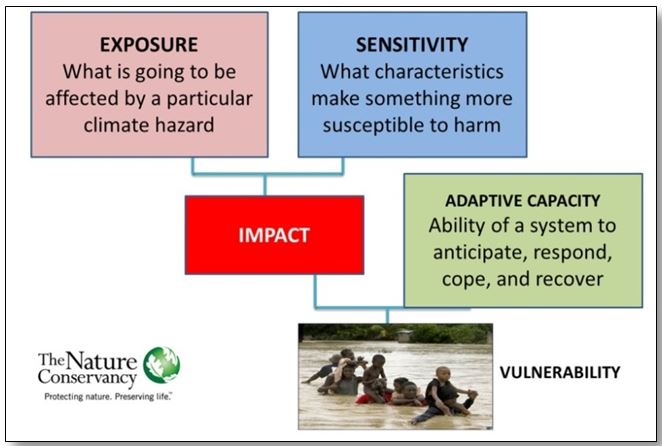
Vulnerability framework that uses exposure and sensitivity to estimate impact that is offset by the calculated adaptive capacity (adapted from Marshall 2009).
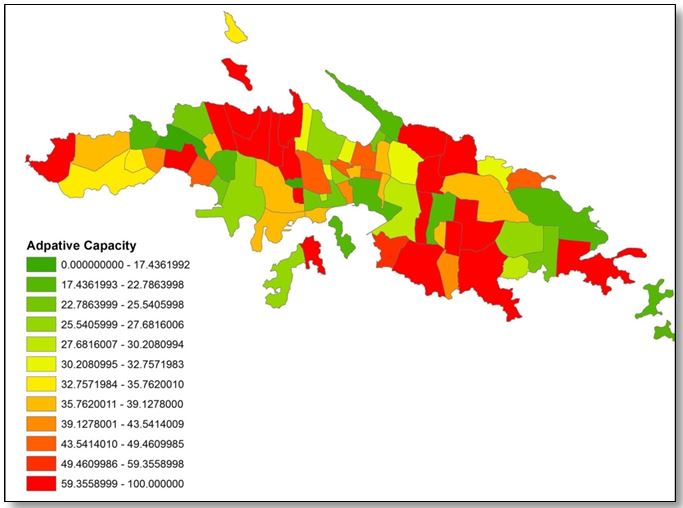
Modeled adaptive capacity in St. Thomas based on 11 parameters from census data. Green shades represent higher levels of adaptive capacity and red shades indicate lower levels of adaptive capacity, or areas that may have more difficulty being able to anticipate, respond to, cope with, and recover from climate impacts (short and long-term).
Mangrove Migration
A mangrove migration analysis was done to identify areas in the USVI where mangroves could potentially migrate in response to sea-level rise (SLR). Rising sea levels will inundate mangroves – forcing them to adapt by migrating to higher areas more suitable for survival. It is important for governments to protect potential mangrove migration lands that are favorable to mangrove growing conditions. In this analysis we used a simple rule-based model to identify areas where mangroves could potentially move based on impediments to landward migration and continuity to existing mangroves. Mangrove migration impediments used in this analysis were buildings, roads, slopes greater than or equal to 10%, and elevations greater than or equal to 5 feet. In application, the mangrove migration analysis selected all landward areas that were contiguous to existing mangroves until it reached an abovementioned impediment. The map below shows the results of the mangrove migration, with the current mangrove extent represented in green and highlighting the potential migration zones in red.
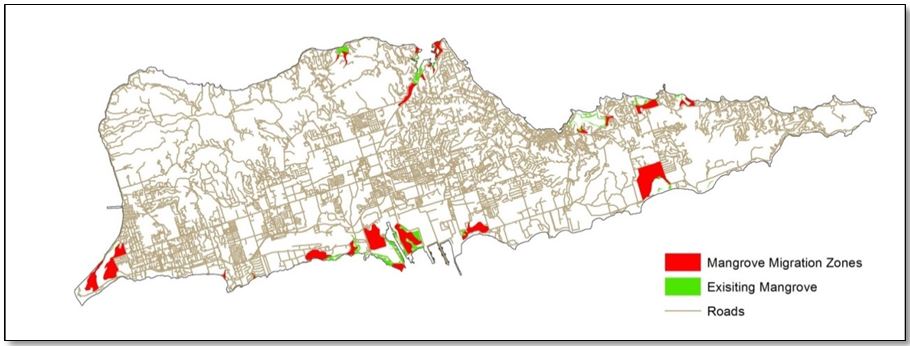
Mangrove mapping in St Croix. Areas in green show the distribution of existing mangrove forests. Areas in red indicate where mangroves may migrate in response to climate change based on mangrove habitat needs.
Identifying EBA Sites
Finally, sites to implement ecosystem-based adaptation were identified and mapped. When choosing optimal areas to implement EBA, the model considers areas that have high impact (exposure and sensitivity) and low adaptive capacity. The variables chosen to calculate the exposure, sensitivity, and adaptive capacity indices for all estates within the USVI were mapped, scaled, and assigned a category of high, medium, or low based on the statistical distribution of the range of values that were calculated. Estates that rank high in exposure represent a high percentage of potential inundation areas from sea-level rise or other flooding events. Estates that ranked high in sensitivity represent areas that are more likely to experience harm based on characteristics that exacerbate the effect of climate exposure. Estates that are both high in exposure and sensitivity constitute high impact areas and require high levels of adaptive capacity to anticipate, respond to, cope with, and recover from climate impacts. The map below shows estates that were selected based on the modeled high impact scores with low adaptive capacity within the USVI.
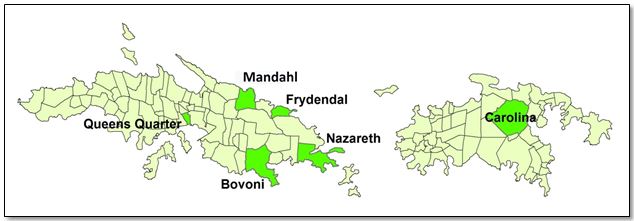
The top ten candidate estates for EBA action in the USVI based on modeled vulnerability and adaptive capacity. The bright green areas represent high impact and low adaptive capacity.
USVI Climate Change EBA Workshop
In June 2013, TNC convened the USVI Climate Change Ecosystem-based Adaptation workshop for decision makers, community leaders, researchers, resources managers, and climate change adaptation practitioners to discuss climate change impacts and adaptation as well as demonstrate methods on the use of geographic information systems (GIS) to identify optimal areas for implementing EBA in the USVI based on ecological and socioeconomic criteria.
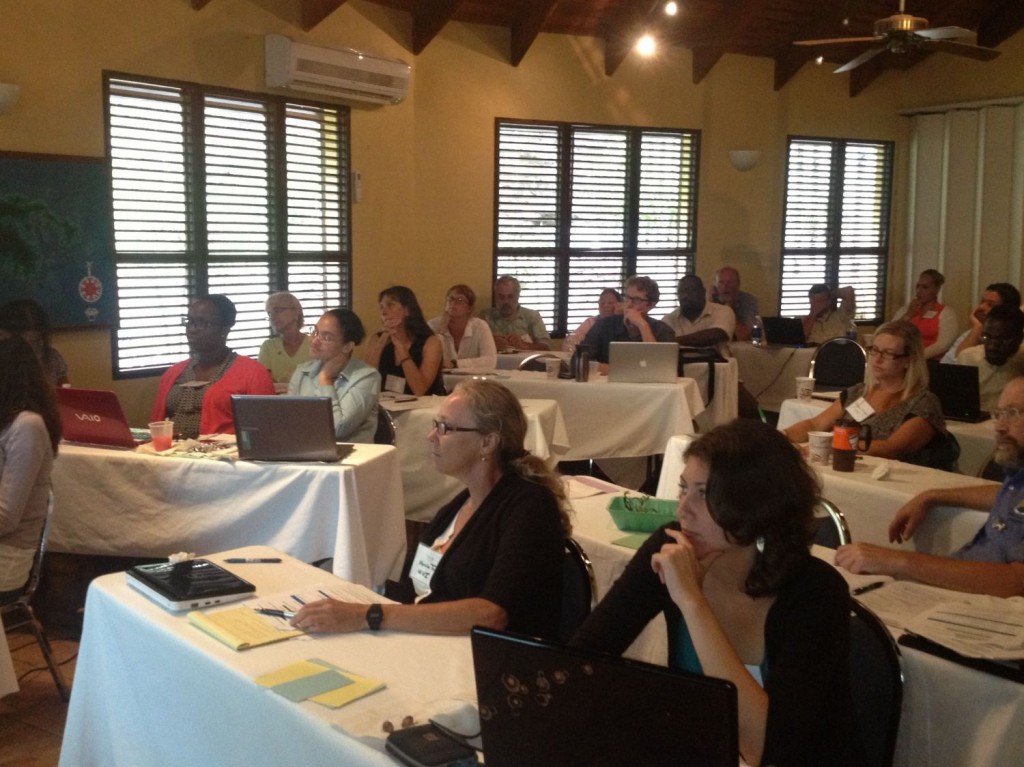
Participants in the USVI Climate Change Ecosystem-based Adaptation workshop. Photo © TNC
During the workshop, TNC presented results from the socioeconomic vulnerability analysis, mangrove migration analysis, and the analysis to identify EBA sites. Workshop participants developed a vision for continuing the work of EBA planning for the territory. Using input from workshop participants and applying mapping tools, the ten coastal areas that were most vulnerable to climate change and least likely to respond were identified. These spatial decision tools were used to develop long-term strategies to create environments that allow for resiliency to changes over time.
How successful has it been?
The US Virgin Islands Climate Change Ecosystem-Based Adaptation Guidance has been a useful tool to educate and inform government agencies of climate change impacts and adaptation opportunities. It has been the bridge for climate change conversations across a change of administration at the USVI governor level. The Guidance document led to funding for coral restoration, an investment in ecosystem based adaptation to increase coral reef resiliency.
Lessons learned and recommendations
- Climate change for small islands will become an increasing challenge. Understanding the vulnerabilities of both humans and natural systems has been a critical first step.
- During a change of government administration, this document was a critical communication piece that served to inform the new governor of climate change impacts and adaptation opportunities.
- Sharing this Guidance with a wide audience has been a challenge. The level of understanding of the public of climate change and its impacts in the US Virgin Islands remains low. Therefore the advanced technical nature of the analyses and results are not well adapted for all audiences. Effort should be invested in preparing materials to effectively communicate to your target audience.
Funding summary
This work was funded through a Cooperative Agreement between The Nature Conservancy and the National Oceanic and Atmospheric Administration’s Coral Reef Conservation Program.
Lead organizations
Partners
The Nature Conservancy
National Oceanic and Atmospheric Administration Coral Reef Conservation Program
U.S. Virgin Islands Department of Planning and Natural Resources
Resources
USVI Climate Change Ecosystem-Based Adaptation Guidance Document

